Useful properties of pomegranate peels and ways to use them
Not only pomegranate berries, but also the peel are consumed for health benefits. In addition to traditional vitamins and minerals, it contains tannins, polyphenols, essential oils, and pectins. Due to its diverse biological composition, pomegranate peels are used for the treatment and prevention of various diseases and conditions.
Despite the fact that many consider pomegranate peel to be absolutely harmless, there are contraindications to its consumption still exist. Therefore, it is permissible to use it as a medicinal product only in cases where the prescription, dosage, and course of treatment are agreed upon with the doctor. In this article we will talk about the beneficial properties, contraindications and uses of pomegranate peels.
Composition and properties of pomegranate peels

Pomegranate peel is characterized by a rich chemical composition:
- water – 81 g;
- organic acids – 1.8 g;
- ash – 0.5 g;
- dietary fiber – 0.9 g;
- sugar –14.5 g;
- fatty acids – 0.1 g;
- omega-6 – 0.079 g.
The vitamin-mineral complex is represented by the following elements (per 100 g):
- A – 0.5 mcg;
- beta-carotene – 0.03 mg;
- B1 – 0.04 mg;
- B2 – 0.01 mg;
- B3 – 0.4 mg;
- B4 – 7.6 mg;
- B5 – 0.54 mg;
- B6 – 0.5 mg;
- B9 – 18 mcg;
- C – 4 mg;
- E – 0.4 mg;
- H – 0.4 µg;
- K – 16.4 mcg;
- PP – 0.5 mg;
- potassium – 150 mg;
- calcium – 10 mg;
- magnesium – 2 mg;
- sodium – 2 mg;
- sulfur – 16.7 mg;
- phosphorus – 8 mg;
- chlorine – 2 mg;
- iron – 1 mg;
- iodine – 2 mcg;
- cobalt – 2.1 mcg;
- manganese – 0.119 mg;
- copper – 158 mcg;
- molybdenum – 5.1 mcg;
- selenium – 0.5 mcg;
- fluoride – 58.7 mcg;
- chromium – 1.5 mcg;
- zinc – 0.35 mg.
Pomegranate skins have immunostimulating, diuretic, choleretic, antioxidant, adsorbent, antimicrobial effects, improve the functions of individual organs and systems, and contribute to the overall health of the body.
Biological and nutritional value
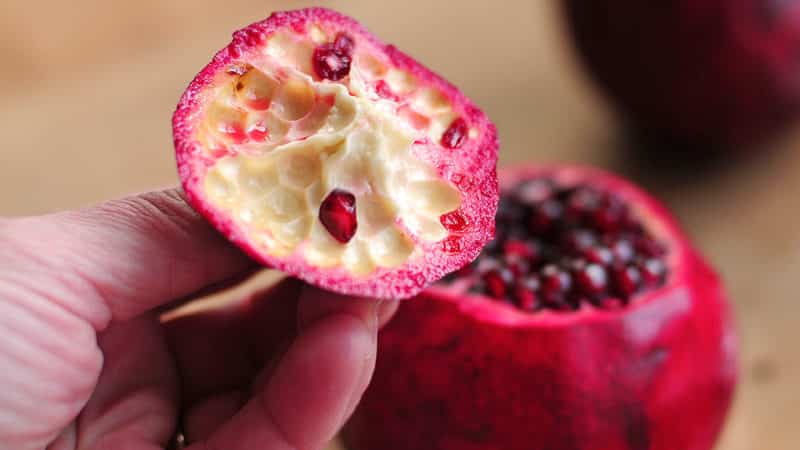
Pomegranate peel has a low calorie content - 72 kcal and a relatively low glycemic index - 35 units.
BJU per 100 g:
- proteins – 0.7 g;
- fats – 0.6 g;
- carbohydrates – 14.5 g.
Nutritional value and chemical composition depend on the variety, climatic growing conditions, and degree of fruit ripeness.
Harm and benefit
Pomegranate peels are an effective vitamin remedy that serves as an additional source of ascorbic acid, tocopherol, retinol, magnesium, sodium, which are responsible for the normal functioning of the immune system.
Active components protect against flu, colds, genitourinary and other infectious diseases. For existing pathologies, they alleviate the severity of symptoms, shorten recovery time, reduce the need for medications, and prevent possible complications.
Pomegranate peel is a powerful antioxidant that protects organs and tissues from the damaging effects of free radicals, prevents the formation and growth of cancer cells, and also slows down the aging process.
Vitamins and minerals contained in pomegranate peel have a positive effect on the cardiovascular system:
- reduce levels of bad cholesterol in the blood, prevent the development of atherosclerosis;
- regulate insulin levels, which is especially important for people with diabetes;
- improve capillary blood flow and reduce the permeability of vascular walls;
- take part in the formation of red blood cells;
- prevent the development of anemia.
Possessing pronounced diuretic and choleretic properties, pomegranate peels remove excess fluid from the body, relieve swelling, and lower blood pressure.
Pomegranate skins alleviate diseases of the musculoskeletal system: arthritis, arthrosis, gout, osteochondrosis. They normalize metabolism, gently and painlessly remove heavy metal salts from the body along with urine. Regular use of a decoction/infusion of pomegranate peel relieves inflammation and reduces the intensity of pain.
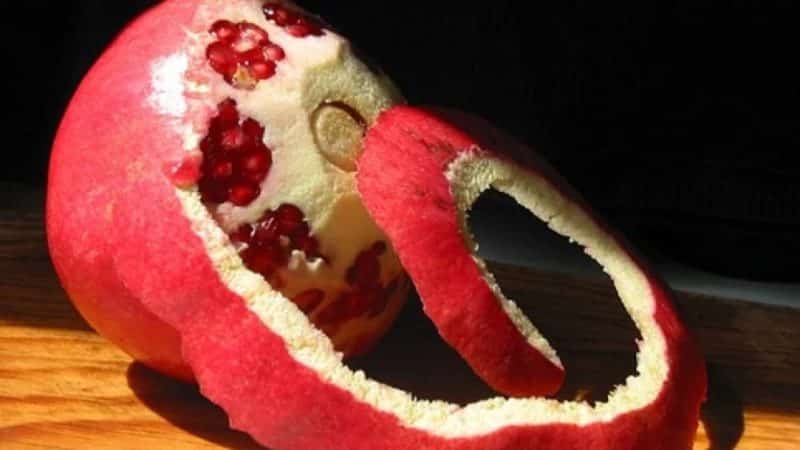
Pomegranate peel is good for the nervous system. B vitamins have an antispasmodic and calming effect, reduce psycho-emotional arousal, facilitate the process of falling asleep and improve the quality of sleep. Pomegranate peels are of particular value for people whose activities involve intellectual and emotional stress.
The biologically active components of pomegranate peel are necessary for the full functioning of the reproductive, visual, and digestive systems.
A decoction made from pomegranate peels promotes natural weight loss. Dietary fiber stimulates digestion, regulates all types of metabolism, accelerates the process of fat breakdown, and gently cleanses the intestines of accumulated waste and toxins. They provide quick and long-lasting satiety, stimulate physical activity, and accordingly, additional calories are consumed. The skins have a mild laxative effect, restore the intestinal microflora, preventing the development of dysbacteriosis.
In folk medicine, a decoction of pomegranate peels is used to treat dermatological and helminthic diseases, and is used to heal wounds, burns, and as an adjuvant that increases the effectiveness of antibiotics.
The harm of pomegranate peel is associated with the presence of alkaloids in the composition. This is plant ash, which in small doses has a healing effect, but in large doses it is poisonous. Unsystematic use of medicine prepared from pomegranate skins will cause intoxication of the body, which is manifested by weakness, nausea, dizziness, and convulsions.
Important. Pomegranate peel is a strong allergen. If the permissible norm is exceeded, a local allergic reaction may develop in the form of a rash, peeling of the skin, hives, and swelling.
Therapeutic effects on the body
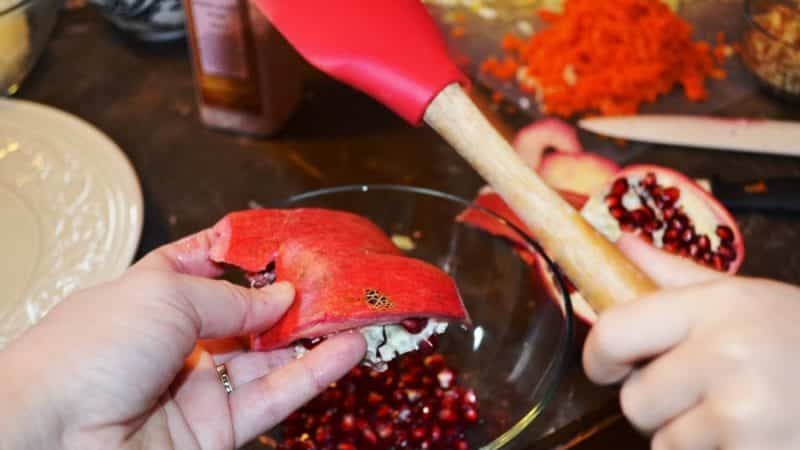
The benefits and harms of pomegranate peel depend on the appropriateness of use, dosage and correct use.
For existing pathologies, skins are used in addition to the main therapeutic methods. This is a herbal product that does not contain aggressive chemical components, so its effectiveness is usually not enough to counteract the developed disease.
For the gastrointestinal tract
In folk medicine, a decoction of pomegranate peels is used to treat diseases of the digestive system: colitis, enterocolitis, dysbacteriosis. Having astringent properties, the skins alleviate the severity of symptoms of gastric and duodenal ulcers and increased acidity of gastric juice.
Pomegranate peel stimulates intestinal peristalsis, as a result, food masses move more easily and quickly through the gastrointestinal tract, thereby ensuring regular stool and clearing the intestines of waste and toxins.The crusts also accelerate the healing process of damaged mucosa and regulate the intestinal microflora.
For gums
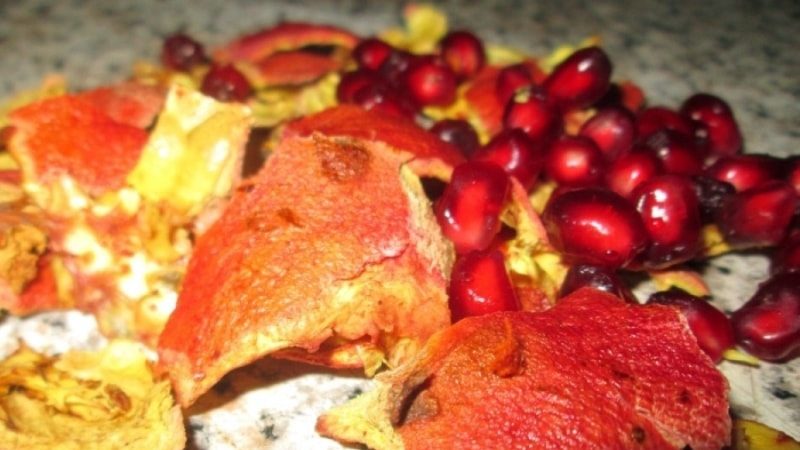
Decoction based on skins grenade Recommended for use in case of gum damage of an infectious or traumatic nature.. If diseases are caused by viruses, bacteria, fungi, then the peel acts as a local antibiotic - it inhibits growth or completely destroys pathogens, and prevents the spread of infection throughout the body. With regular use of the remedy, swelling subsides, pain intensity decreases, and bleeding when brushing teeth disappears.
In case of traumatic damage to gum tissue, pomegranate peel accelerates the healing process and protects the mucous membranes from infections. Vitamin C, together with calcium, increases bone density and ensures mineralization of teeth.
From parasites
Pomegranate skins have a broad spectrum antiparasitic effect. They cause the death of roundworms, bovine and pork tapeworms, tapeworms, Giardia, pinworms, and echinococci. As the remedy is used, the severity of toxic-allergic manifestations decreases: skin rash, muscle pain, irritability, fatigue, nausea, heartburn.
For intestinal helminthiases, a decoction of pomegranate peels is used as a powerful sorbent to restore favorable intestinal microflora and reduce the harmful effects of antibiotics.
For burns
Due to their anti-inflammatory and wound-healing properties, skins are used to treat and prevent complications of various dermatological diseases (acne, dermatoses, diaper rash, fungal infections).
For wounds and burns, pomegranate peel prevents the penetration of pathogenic microorganisms into the open cavity, stimulates tissue regeneration, improves blood microcirculation and local metabolism.
Vitamins and minerals contained in pomegranate peel have a beneficial effect on the skin:
- stimulate collagen production;
- slow down the aging process;
- tone;
- moisturize;
- protect from the negative effects of sunlight;
- regulate the functioning of the sebaceous glands.
How to use pomegranate peels in cooking

In cooking, dried and crushed pomegranate peels are added in small doses to baked goods, desserts, and used to prepare sauces and marinades for meat, chicken, and fish. They give the dish a specific aroma and a unique sweet and sour taste.
Aromatic and healthy tea is brewed from pomegranate skins, which not only quenches thirst, but also prevents the development of many diseases.
In folk medicine
Depending on the therapeutic objectives, a decoction or infusion is prepared on the basis of pomegranate peel, which is taken internally or externally in the form of compresses, and a tonic tea is brewed. For diseases of the oral cavity, it is used as a rinse.
How to prepare the decoction:
- 2 tsp. dried crushed pomegranate peel pour 1 tbsp. boiling water Place in a water bath and cook for 20-30 minutes from the moment it boils.
- Cool, covered, at room temperature, strain. How to take and in what quantity should be discussed with a specialist.
This decoction is used to sanitize the oral cavity for stomatitis, gingivitis, swelling and bleeding of the gums, and to relieve sore throat due to infectious diseases of the respiratory system.The decoction is taken orally for digestive disorders, diarrhea, hypo- and avitaminosis.
How to make tea:
- 1 tbsp. l. crushed pomegranate peel, pour 200 ml of hot water (temperature 90-95°C).
- Leave covered for 20-30 minutes, strain. If desired, add 1 tsp. natural honey, cinnamon, lemon, mint, lemon balm.
This tea alleviates problems with digestion, stomach or duodenal ulcers. The vitamin and mineral composition has a calming effect on the nervous system, relieves tension, tones, increases endurance and ability to work.
For the treatment and prevention of worms, the infusion is prepared as follows:
- Place 50 g of pomegranate peels into an airtight container (thermos or pan with a tight-fitting lid), pour 500 ml of boiling water.
- Infuse in an airtight closed container for 5-6 hours. Then strain through cheesecloth folded in several layers or a colander.
- Drink 250 ml of infusion at a time, after 30 minutes take a laxative.
- Then you cannot eat or drink for 3 hours. After 4 hours, do an enema to remove helminth decay products that are toxic to the human body.
To heal wounds, burns, ulcers and other damage to the skin, dried pomegranate peels, crushed into powder, are used. They are poured onto the sore spot and secured with gauze on top. Treatment is carried out daily until complete healing.
In cosmetology
Pomegranate peels are brewed and used to rinse hair. If used regularly, this decoction effectively strengthens and regenerates hair and promotes active growth. It is recommended to use pomegranate skins for seborrhea, baldness, and to strengthen hair roots.
To prepare the decoction you will need crushed fresh or dried peels of two pomegranates and 1 liter of boiling water. Mix all ingredients, boil for 5 minutes, leave covered for 1-2 hours, cool and strain. Rinse your hair with the decoction after each wash.
Crushed pomegranate peels can replace expensive cosmetic peels. They carefully exfoliate dead cells, even out the skin and complexion, prevent inflammation, improve blood circulation and metabolism.
Pomegranate peel in homemade masks performs several functions simultaneously:
- prevents the appearance of early wrinkles;
- reduces pigmentation;
- protects against negative external influences (scorching sun, cold air, wind);
- eliminates dryness and tightness;
- gives the face a matte and healthy color.
How to prepare and store crusts
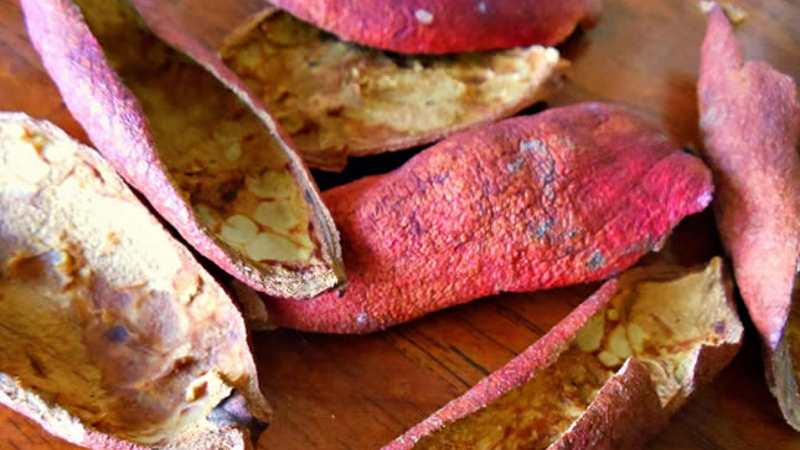
The healing and beneficial properties of the peel partly depend on the quality of the pomegranate. When buying fruit in a store, market or supermarket, pay attention to its appearance:
- Peel. A ripe fruit has a thin, slightly dried skin, uniform in color (from light yellow to deep red), firm to the touch, with a glossy sheen, without signs of spoilage or damage.
- Weight. A good pomegranate is heavy - 600-800 g. With light pressure, you can feel the crunch of ripe grains.
- Cup. Dry, open, should not be green.
The fruits begin to ripen at the end of September, so the optimal time for harvesting the peel is October-November. When buying pomegranates out of season, there is a possibility of purchasing a product with a dangerous nitrate content.
Making crusts is simple:
- Wash the fruits thoroughly, dry, and peel.
- Clean the skins from the leathery pericarp, rinse well again, and remove any remaining moisture with a paper towel.
- Place the peel on a napkin, cover with gauze on top, leave in the room until completely dry (for 5-10 days depending on air temperature and humidity). Turn the crusts over periodically so that they dry evenly.
- To speed up the drying process, use an oven, microwave, or air fryer.
When prepared correctly, the peel retains its characteristic dark burgundy color, becomes brittle to the touch, and crumbles when compressed. Store the product in sealed glass jars under a lid in a dry place protected from the sun. The shelf life of the product is 12 months.
For reference. If brown spots appear on the skin during storage, this means that it is unsuitable for use.
Crushed pomegranate peel is used as a medicinal raw material, so it is first pounded in a mortar or crushed in a blender or coffee grinder.
Contraindications
Pomegranate peel has a minimum of contraindications for use in folk medicine and cosmetology:
- allergy to the product;
- constipation;
- hemorrhoids and anal fissures;
- severe renal/liver failure;
- tendency to any type of bleeding.
Due to the high degree of allergenicity, it is used with caution during pregnancy and lactation, in relation to children and adolescents, when all actions must be previously agreed with the attending physician. The simultaneous use of a medicinal product based on pomegranate peel and antiallergic drugs is not allowed.
This is interesting:
A step-by-step guide to propagating pomegranate from cuttings at home.
Beginner's Guide: How to Care for Potted Pomegranates at Home.
Conclusion
The beneficial properties of pomegranate peels depend on the characteristics of the disease, the appropriateness of use, the presence of contraindications, dosage and treatment regimen. Skins have a versatile positive effect on the body: strengthen the immune system, protect against infections, prevent diseases of the heart, blood vessels, and digestive organs, and stimulate the regeneration of tissues and mucous membranes.
To preserve the beneficial and medicinal properties of pomegranate peel, it is important to choose high-quality and ripe fruits, prepare and store them correctly.